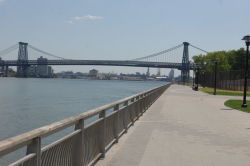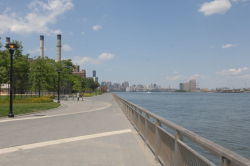John V. Lindsay East River Park
John V. Lindsay East River Park
What was here before?
Originally marshland that was used by the Lenape tribe to land their canoes, the area’s gradual coastal incline proved advantageous to Dutch settlers of the mid-1600s in the loading and unloading of various types of cargo. The waterfront remained integral to the shipping industry for over 200 years. In the mid-19th century, as sea trade moved to the deeper channels of the Hudson River, docks gave way to factories, and then, in the late 19th century, to tenements.
The pier was used as a newsprint terminal in 1963 but then became integral to the banana industry, with an estimated 935 million bananas arriving every year. It received its last shipment in November 1987 and remained unused for almost 20 years.
How did this site become a park?
This city-owned property was transferred to NYC Parks in 2012. As part of a coastal resiliency project, Pier 42 was upgraded to protect the neighborhood from flooding while also creating a new recreational space with waterfront access. The project was mainly funded by a grant from the Lower Manhattan Development Corporation.
Positioned at the crossroads of two major resilience initiatives —the East Side Coastal Resiliency and Brooklyn Bridge-Montgomery Coastal Resiliency projects—Pier 42 will help form a 3.2-mile flood barrier. This barrier will safeguard over 150,000 residents, many of whom were impacted by Superstorm Sandy. Led by the DDC, NYC Parks, and other city agencies, the project not only focuses on flood protection but also aims to improve the area's coastline and accessibility.
Pier 42 is a key connector between several existing parks and green spaces. It links the John V. Lindsay East River Park and Corlears Hook parks to the north, and the Greenway to the south. This connection creates a seamless waterfront experience, integrating these areas into a continuous public space.
The park has multigenerational play areas that include a synthetic turf hill, climbing features, musical play elements, and a water feature activated by touch-bollard. Multiple sports courts for soccer, tennis, and basketball can be found on the pier deck near the adult fitness area. The park house is equipped with ADA-compliant bathrooms and water fountains with a green roof.
What is this park named for?
In the early days of New York, the waterfront was disorganized as the city grew around its natural harbor. By the 19th century, as the port became busier, a more formal system for managing piers was needed.
In the early 1800s, New York City's piers and docks were managed by local authorities and private individuals. As port activities grew, a more organized structure was needed. In 1866, the Department of Docks and Ferries was established to oversee the waterfront, regulating the construction, maintenance, and leasing of piers. This department played a key role in organizing the piers, assigning numbers, and facilitating port operations.
Piers were numbered sequentially to improve coordination of shipping activities. Piers along the East River and Hudson River were numbered separately, with East River piers labeled “East” and Hudson River piers labeled “West.” The numbering system progressed northward from the southern tip of Manhattan.
Today, while some piers are repurposed for parks, tourism, and recreation, the pier numbering system remains a part of the city's infrastructure legacy.
Check out your park's Vital Signs
Clean & Safe
Green & Resilient
Empowered & Engaged Users
Share your feedback or learn more about how this park is part of a
Vital Park System

Know Before You Go
The section of East River Park south of Stanton Street is temporarily closed due to construction as part of the East Side Coastal Resiliency Project, which will protect Lower East Side residents and waterfront parks from coastal storms and sea level rise. East River Park remains open north of Stanton Street. For access to open park areas, use entrances at E. Houston Street, 6th St Bridge, or 10th St Bridge. For more information on construction progress, when this section of the park will re-open, please visit the Department of Design and Construction’s City’s East Side Coastal Resiliency Project Updates page. If you are looking for places to play and relax nearby, please visit our Neighborhood Recreational Resources page.











